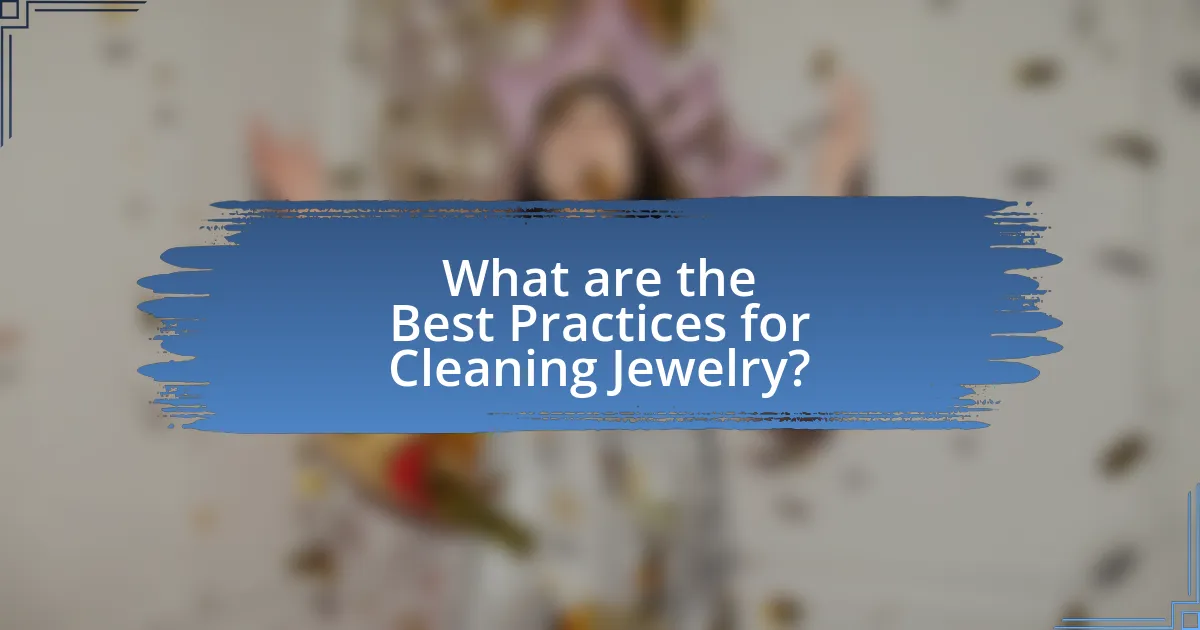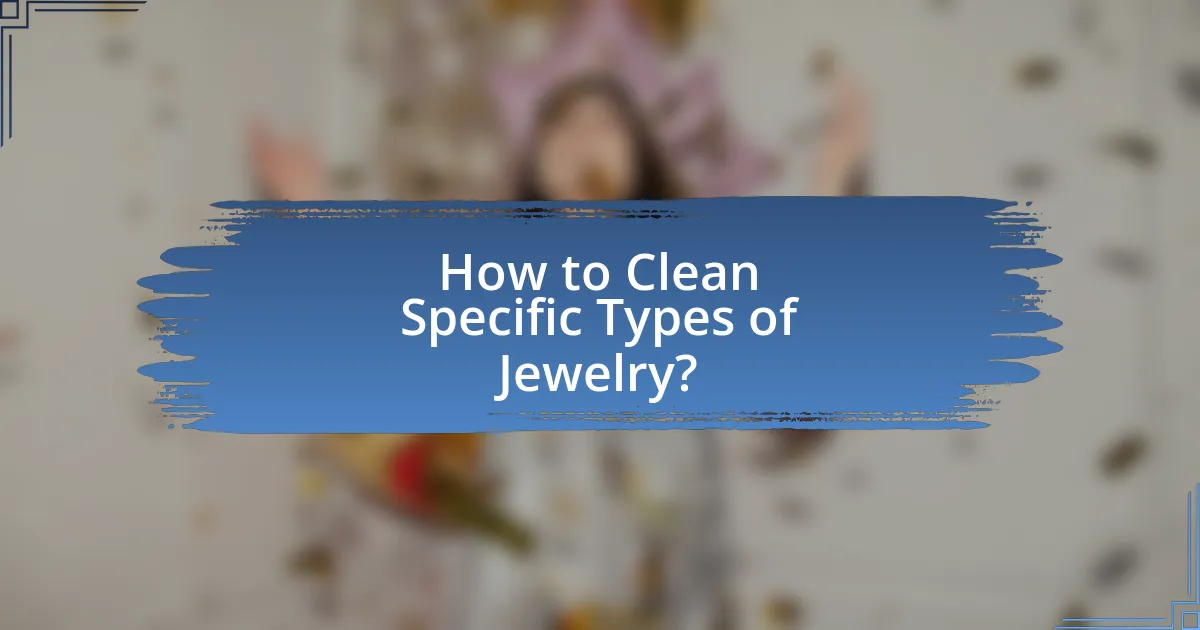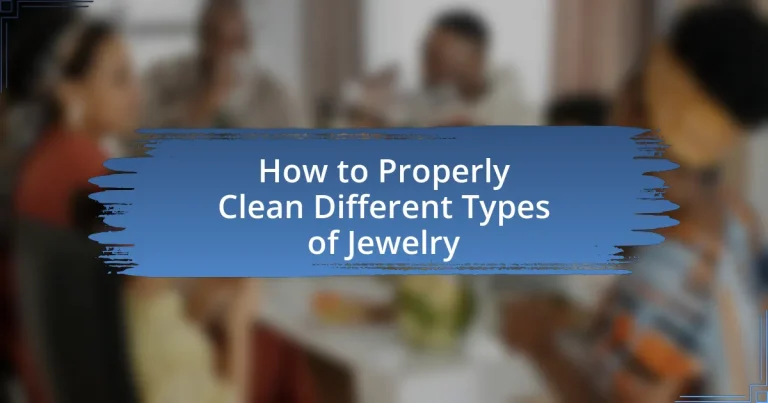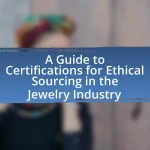The article focuses on the proper cleaning methods for various types of jewelry, including necklaces, bracelets, earrings, rings, brooches, and anklets. It details how different materials, such as gold, silver, platinum, and gemstones, influence cleaning techniques and the importance of regular maintenance to prevent damage and preserve appearance. The article also outlines best practices for cleaning specific types of jewelry, recommended cleaning solutions, and essential tools needed for effective care. Additionally, it highlights common mistakes to avoid and practical tips for maintaining jewelry cleanliness and longevity.

What are the Different Types of Jewelry?
The different types of jewelry include necklaces, bracelets, earrings, rings, brooches, and anklets. Each type serves a unique purpose and can be made from various materials such as gold, silver, gemstones, and pearls. For instance, necklaces can be simple chains or elaborate pieces adorned with pendants, while earrings can range from studs to chandeliers. Rings often symbolize commitment or fashion, and brooches are typically used as decorative fasteners. Anklets are worn around the ankle and can be casual or ornate. This classification is widely recognized in the jewelry industry and is essential for understanding how to care for and clean each type effectively.
How do the materials used in jewelry affect cleaning methods?
The materials used in jewelry significantly influence the cleaning methods employed. Different materials, such as gold, silver, platinum, and gemstones, have varying levels of durability and susceptibility to damage from cleaning agents. For instance, gold and platinum are resistant to tarnishing and can be cleaned with mild soap and water, while silver tarnishes easily and may require specialized silver polish. Additionally, softer gemstones like opals and pearls can be damaged by harsh chemicals, necessitating gentle cleaning methods, such as using a soft cloth and lukewarm water. Therefore, understanding the specific properties of each material is essential for selecting appropriate cleaning techniques that preserve the integrity and appearance of the jewelry.
What are the common materials found in jewelry?
Common materials found in jewelry include gold, silver, platinum, and various gemstones such as diamonds, rubies, and sapphires. Gold is widely used due to its malleability and resistance to tarnish, while silver is popular for its affordability and luster. Platinum is favored for its durability and hypoallergenic properties. Gemstones are often incorporated for their aesthetic appeal and rarity, with diamonds being the most sought-after due to their hardness and brilliance. These materials are foundational in the jewelry industry, influencing both design and cleaning methods.
How does each material influence the cleaning process?
Different materials significantly influence the cleaning process of jewelry due to their unique properties and reactions to cleaning agents. For instance, gold is resistant to tarnishing and can be cleaned with mild soap and water, while silver tarnishes easily and requires specific silver cleaners or polishing cloths to restore its shine.
Additionally, gemstones like diamonds can withstand ultrasonic cleaners, but softer stones such as opals and pearls may be damaged by harsh chemicals or excessive scrubbing, necessitating gentler cleaning methods. Furthermore, materials like stainless steel are durable and can be cleaned with a variety of solutions without risk of damage, whereas porous materials like leather require specialized care to avoid deterioration.
These material-specific characteristics dictate the appropriate cleaning methods, ensuring that the jewelry is maintained without compromising its integrity or appearance.
Why is it important to clean jewelry regularly?
Cleaning jewelry regularly is important to maintain its appearance and prevent damage. Regular cleaning removes dirt, oils, and tarnish that can accumulate over time, which helps preserve the jewelry’s shine and luster. Additionally, neglecting to clean jewelry can lead to the buildup of harmful substances that may cause corrosion or degradation of materials, particularly in pieces made of precious metals or gemstones. For instance, a study by the Gemological Institute of America highlights that regular maintenance can extend the lifespan of jewelry significantly, ensuring that it remains in good condition for years.
What are the potential risks of not cleaning jewelry?
Not cleaning jewelry can lead to several potential risks, including skin irritation, tarnishing, and loss of luster. Skin irritation occurs when dirt, oils, and bacteria accumulate on jewelry, which can cause allergic reactions or infections. Tarnishing happens when metals like silver and copper react with moisture and air, leading to discoloration and damage. Additionally, neglecting to clean jewelry can result in the loss of gemstones’ brilliance due to the buildup of grime, ultimately diminishing the piece’s aesthetic value. Regular cleaning helps maintain both the hygiene and appearance of jewelry, preventing these risks.
How does regular cleaning extend the life of jewelry?
Regular cleaning extends the life of jewelry by removing dirt, oils, and tarnish that can cause damage over time. Accumulated grime can lead to scratches, dullness, and even corrosion, particularly in metals like silver and gold. For instance, a study published in the Journal of Materials Science found that regular maintenance can significantly reduce the wear and tear on jewelry, preserving its appearance and structural integrity. By maintaining cleanliness, jewelry retains its luster and minimizes the risk of costly repairs or replacements.

What are the Best Practices for Cleaning Jewelry?
The best practices for cleaning jewelry include using a gentle soap solution, soft brushes, and microfiber cloths. To clean most jewelry, mix a few drops of mild dish soap with warm water, soak the pieces for a few minutes, and gently scrub with a soft brush to remove dirt and grime. Rinse thoroughly with clean water and dry with a microfiber cloth to avoid scratches. For specific materials, such as pearls or opals, avoid soaking and instead use a damp cloth to wipe them clean, as they can be sensitive to moisture. Regular cleaning helps maintain the jewelry’s appearance and prevents buildup that can lead to damage.
How can you identify the right cleaning method for each type of jewelry?
To identify the right cleaning method for each type of jewelry, first, determine the material composition of the jewelry, as different materials require specific care. For example, gold and platinum can typically be cleaned with mild soap and water, while pearls and opals need gentler methods, such as using a soft cloth and avoiding immersion in water. Additionally, consider the presence of gemstones; some stones, like diamonds, can withstand ultrasonic cleaners, while others, like emeralds, may be damaged by such methods. Research indicates that using the appropriate cleaning method not only preserves the jewelry’s appearance but also extends its lifespan, as improper cleaning can lead to damage or dullness.
What are the recommended cleaning solutions for different materials?
For cleaning different types of jewelry, the recommended cleaning solutions vary by material. For gold and platinum, a mixture of warm water and mild dish soap is effective. For silver, a specialized silver cleaner or a paste made from baking soda and water can remove tarnish. For gemstones, a gentle soap solution is suitable, while pearls require a damp cloth and should avoid harsh chemicals. For costume jewelry, a soft cloth and mild soap are recommended to prevent damage. These solutions are widely endorsed by jewelers and cleaning experts for their effectiveness and safety on respective materials.
How do you safely use ultrasonic cleaners?
To safely use ultrasonic cleaners, first ensure that the jewelry is suitable for ultrasonic cleaning, as not all materials can withstand the process. Next, fill the ultrasonic cleaner with the appropriate cleaning solution, typically a mixture of water and a specialized ultrasonic cleaning detergent, to enhance cleaning efficiency. Then, place the jewelry in the basket provided, ensuring it does not touch the bottom of the tank to prevent damage. Operate the cleaner according to the manufacturer’s instructions, usually for a duration of 3 to 10 minutes, depending on the level of dirt and the type of jewelry. Finally, rinse the jewelry thoroughly with clean water and dry it with a soft cloth to remove any remaining cleaning solution. Following these steps minimizes the risk of damage and ensures effective cleaning.
What tools are essential for cleaning jewelry effectively?
Essential tools for cleaning jewelry effectively include a soft-bristle toothbrush, a microfiber cloth, a jewelry cleaning solution, and a small bowl for soaking. The soft-bristle toothbrush allows for gentle scrubbing of intricate designs without scratching the surface, while the microfiber cloth is ideal for polishing and removing smudges. Jewelry cleaning solutions, often formulated with safe ingredients for various metals and stones, help dissolve dirt and grime. Soaking jewelry in a small bowl with the cleaning solution enhances the cleaning process by loosening debris. These tools are widely recommended by jewelers for maintaining the appearance and longevity of jewelry.
Which brushes and cloths are best for jewelry cleaning?
The best brushes for jewelry cleaning are soft-bristled toothbrushes and specialized jewelry cleaning brushes, while the most effective cloths are microfiber and polishing cloths. Soft-bristled toothbrushes gently remove dirt and grime without scratching delicate surfaces, making them ideal for intricate designs. Specialized jewelry cleaning brushes often have softer bristles and are designed specifically for various types of jewelry, ensuring thorough cleaning without damage. Microfiber cloths are effective for polishing and removing fingerprints, as they trap dirt and oils without scratching. Polishing cloths, often treated with cleaning agents, enhance shine and remove tarnish from metals. These tools are widely recommended by jewelers for maintaining the appearance and longevity of jewelry.
How do you use a jewelry cleaning kit properly?
To use a jewelry cleaning kit properly, first read the instructions provided with the kit to understand the specific cleaning solutions and tools included. Next, remove any loose dirt or debris from the jewelry using a soft brush or cloth. Then, apply the cleaning solution as directed, usually by soaking the jewelry for a specified time or applying it with a cloth. After cleaning, rinse the jewelry thoroughly with water to remove any residue from the cleaning solution. Finally, dry the jewelry with a soft, lint-free cloth to prevent water spots. Following these steps ensures effective cleaning while maintaining the integrity of the jewelry.

How to Clean Specific Types of Jewelry?
To clean specific types of jewelry, use appropriate methods tailored to each material. For gold jewelry, a mixture of warm water and mild dish soap is effective; soak for 15 minutes, then gently scrub with a soft brush. For silver jewelry, a silver polishing cloth or a paste of baking soda and water can remove tarnish; apply gently and rinse thoroughly. For diamond jewelry, a solution of warm water and dish soap works well; soak and brush lightly with a soft toothbrush. For pearls, use a damp cloth to wipe them clean, avoiding immersion in water. Each method is validated by jewelry care guidelines from experts, ensuring the longevity and appearance of the pieces.
What are the best methods for cleaning gold jewelry?
The best methods for cleaning gold jewelry include using a mild soap solution, a baking soda paste, or a professional jewelry cleaner. A mild soap solution can be made by mixing warm water with a few drops of dish soap, which effectively removes dirt and oils without damaging the gold. A baking soda paste, created by mixing baking soda with water, can gently scrub tarnished areas without scratching the surface. Additionally, professional jewelry cleaners are specifically formulated for gold and can provide a thorough clean while ensuring the integrity of the metal. These methods are widely recommended by jewelers and can be safely used at home to maintain the shine and appearance of gold jewelry.
How do you remove tarnish from gold pieces?
To remove tarnish from gold pieces, gently clean them using a mixture of warm water and mild dish soap. Soak the gold items for a few minutes, then use a soft cloth or a soft-bristled toothbrush to scrub away the tarnish. Rinse the pieces thoroughly with clean water and dry them with a soft, lint-free cloth. This method is effective because the soap helps to break down tarnish without scratching the gold surface, maintaining its shine and integrity.
What precautions should you take when cleaning gold jewelry?
When cleaning gold jewelry, it is essential to avoid harsh chemicals and abrasive materials. Using a mild soap solution and a soft cloth is recommended to prevent damage to the gold’s surface. Additionally, it is crucial to ensure that any gemstones or other materials set in the jewelry are safe for water exposure, as some may be sensitive to moisture or cleaning agents. Regularly checking for loose stones before cleaning can help prevent loss or damage.
How should silver jewelry be cleaned?
To clean silver jewelry, use a mixture of warm water and mild dish soap, soaking the jewelry for a few minutes before gently scrubbing with a soft cloth or a toothbrush. This method effectively removes tarnish and dirt without damaging the silver. Additionally, using a silver polishing cloth can enhance shine and remove any remaining tarnish. Regular cleaning helps maintain the jewelry’s appearance and prevents buildup.
What are the most effective ways to clean silver without damaging it?
The most effective ways to clean silver without damaging it include using a mixture of baking soda and water, employing a silver polishing cloth, and utilizing a gentle dish soap solution. Baking soda, when mixed with water to form a paste, can effectively remove tarnish without scratching the silver surface. Silver polishing cloths are designed specifically to clean silver and can safely restore shine without causing damage. Additionally, a solution of mild dish soap and warm water can be used to soak silver items, followed by gentle wiping with a soft cloth to avoid scratches. These methods are widely recommended by experts in jewelry care and have been proven effective in maintaining the integrity of silver items.
How can you prevent silver from tarnishing in the future?
To prevent silver from tarnishing in the future, store silver items in airtight containers or anti-tarnish pouches. This method limits exposure to moisture and sulfur, which are primary contributors to tarnishing. Additionally, using silica gel packets in storage can absorb humidity, further protecting the silver. Regularly polishing silver with a soft cloth can also help remove tarnish before it builds up, maintaining its shine. Studies show that silver tarnishes more rapidly in humid environments, so controlling humidity levels is crucial for preservation.
What cleaning techniques are recommended for gemstone jewelry?
To clean gemstone jewelry, it is recommended to use a mild soap solution and a soft brush. This technique effectively removes dirt and oils without damaging the gemstones. Specifically, a mixture of warm water and a few drops of mild dish soap can be used to soak the jewelry for a few minutes. After soaking, gently scrub the gemstones with a soft-bristled toothbrush to dislodge any debris. Rinsing the jewelry under lukewarm water and drying it with a soft cloth ensures that no soap residue remains. This method is widely endorsed by jewelers and gemologists for its effectiveness and safety in preserving the integrity of various gemstones.
How do you clean delicate gemstones safely?
To clean delicate gemstones safely, use a soft, lint-free cloth and lukewarm water mixed with a mild soap. Gently wipe the gemstone with the cloth, avoiding harsh chemicals and ultrasonic cleaners, which can damage sensitive stones. For example, pearls and opals are particularly vulnerable to chemical exposure and should only be cleaned with this gentle method. This approach ensures that the integrity and appearance of the gemstones are preserved while effectively removing dirt and oils.
What specific care do different gemstones require during cleaning?
Different gemstones require specific care during cleaning to avoid damage. For example, diamonds can be cleaned with warm soapy water and a soft brush, while pearls should be wiped with a damp cloth and never soaked, as they can be sensitive to chemicals and moisture. Opals require gentle cleaning with a soft cloth and should not be exposed to extreme temperatures or harsh chemicals, as they can crack. Emeralds should be cleaned with a soft cloth and warm soapy water, avoiding ultrasonic cleaners due to their potential inclusions. Sapphires and rubies can generally withstand ultrasonic cleaning but should still be cleaned with care to maintain their luster. Each gemstone’s unique properties dictate the appropriate cleaning method to ensure their longevity and appearance.
How can you clean costume jewelry without damaging it?
To clean costume jewelry without damaging it, use a soft, lint-free cloth to gently wipe the surface and remove dirt or oils. Avoid using harsh chemicals or abrasive materials, as these can tarnish or scratch the jewelry. Instead, create a mild cleaning solution with warm water and a few drops of dish soap, then dip the cloth into the solution, wring it out, and carefully clean the jewelry. Rinse the jewelry with clean water and dry it thoroughly with a separate soft cloth to prevent moisture damage. This method is effective because it minimizes exposure to damaging substances while ensuring the jewelry remains clean and intact.
What are the best practices for cleaning faux gemstones?
The best practices for cleaning faux gemstones include using a soft, lint-free cloth to gently wipe the surface, avoiding harsh chemicals, and using a mild soap solution for deeper cleaning. Faux gemstones, often made from materials like glass or resin, can be damaged by abrasive cleaners or excessive scrubbing. A mixture of warm water and a few drops of mild dish soap is effective for cleaning; soak the gemstones briefly and then wipe them clean with a soft cloth. This method preserves their appearance and prevents scratching.
How do you handle glued components in costume jewelry?
To handle glued components in costume jewelry, carefully assess the type of adhesive used and the materials involved. For cleaning, use a soft, damp cloth to gently wipe the surface without applying excessive pressure, which could weaken the bond. Avoid submerging the jewelry in water or using harsh chemicals, as these can damage the glue and the components. Research indicates that many costume jewelry pieces are made with water-soluble adhesives, which can dissolve if exposed to moisture, leading to component detachment. Therefore, maintaining a dry cleaning method is essential for preserving the integrity of glued components.
What are the common mistakes to avoid when cleaning jewelry?
Common mistakes to avoid when cleaning jewelry include using harsh chemicals, which can damage the metal and stones, and neglecting to test cleaning solutions on a small area first. Additionally, using abrasive materials like steel wool can scratch surfaces, while failing to dry jewelry properly can lead to tarnishing. Not considering the specific care requirements for different materials, such as pearls or opals, can also result in damage. These practices are widely recognized in jewelry care guidelines, emphasizing the importance of using gentle, appropriate methods for each type of jewelry to maintain its integrity and appearance.
How can improper cleaning methods damage jewelry?
Improper cleaning methods can damage jewelry by causing scratches, tarnishing, or weakening the structural integrity of the pieces. For example, using abrasive materials can scratch delicate surfaces, while harsh chemicals can lead to discoloration or corrosion of metals and gemstones. Additionally, excessive heat or improper drying techniques can weaken settings, potentially leading to lost stones. Studies have shown that certain cleaning agents, like bleach, can irreversibly damage precious metals, confirming the importance of using appropriate cleaning methods tailored to specific jewelry types.
What should you never use when cleaning jewelry?
You should never use harsh chemicals, such as bleach or ammonia, when cleaning jewelry. These substances can damage the metal and stones, leading to discoloration or deterioration. For example, bleach can weaken gold and silver, while ammonia can harm certain gemstones like pearls and opals. Therefore, using gentle, jewelry-specific cleaners is essential to maintain the integrity and appearance of your jewelry.
What are some practical tips for maintaining jewelry cleanliness?
To maintain jewelry cleanliness, regularly clean pieces with a soft cloth to remove dirt and oils. For deeper cleaning, use a mild soap solution and a soft brush, ensuring to rinse thoroughly and dry completely. Avoid exposing jewelry to harsh chemicals, and store items separately to prevent scratching. These practices help preserve the shine and integrity of various materials, including gold, silver, and gemstones. Regular maintenance can extend the lifespan of jewelry, as dirt buildup can lead to tarnishing and damage over time.
How often should you clean different types of jewelry?
Different types of jewelry should be cleaned at varying frequencies based on their materials and usage. Fine jewelry, such as gold and platinum, should be cleaned every 1-2 months to maintain its shine and remove dirt. Silver jewelry requires cleaning every 2-3 weeks to prevent tarnishing. Costume jewelry should be cleaned every 3-6 months, as it is often less durable and can be damaged by frequent cleaning. Pearls and other delicate gemstones should be cleaned after each wear to avoid buildup of oils and dirt. Regular cleaning helps preserve the integrity and appearance of the jewelry, ensuring it remains in good condition over time.
What storage solutions help keep jewelry clean and safe?
Jewelry boxes with individual compartments help keep jewelry clean and safe by preventing scratches and tangling. These boxes often feature soft linings that protect delicate pieces from dust and damage. Additionally, anti-tarnish pouches or cloths can be used to store silver jewelry, as they inhibit tarnishing by absorbing moisture and sulfur. Furthermore, using clear plastic bags for each piece can provide visibility while protecting against environmental factors. Studies indicate that proper storage significantly extends the lifespan of jewelry, as it minimizes exposure to air and contaminants.


